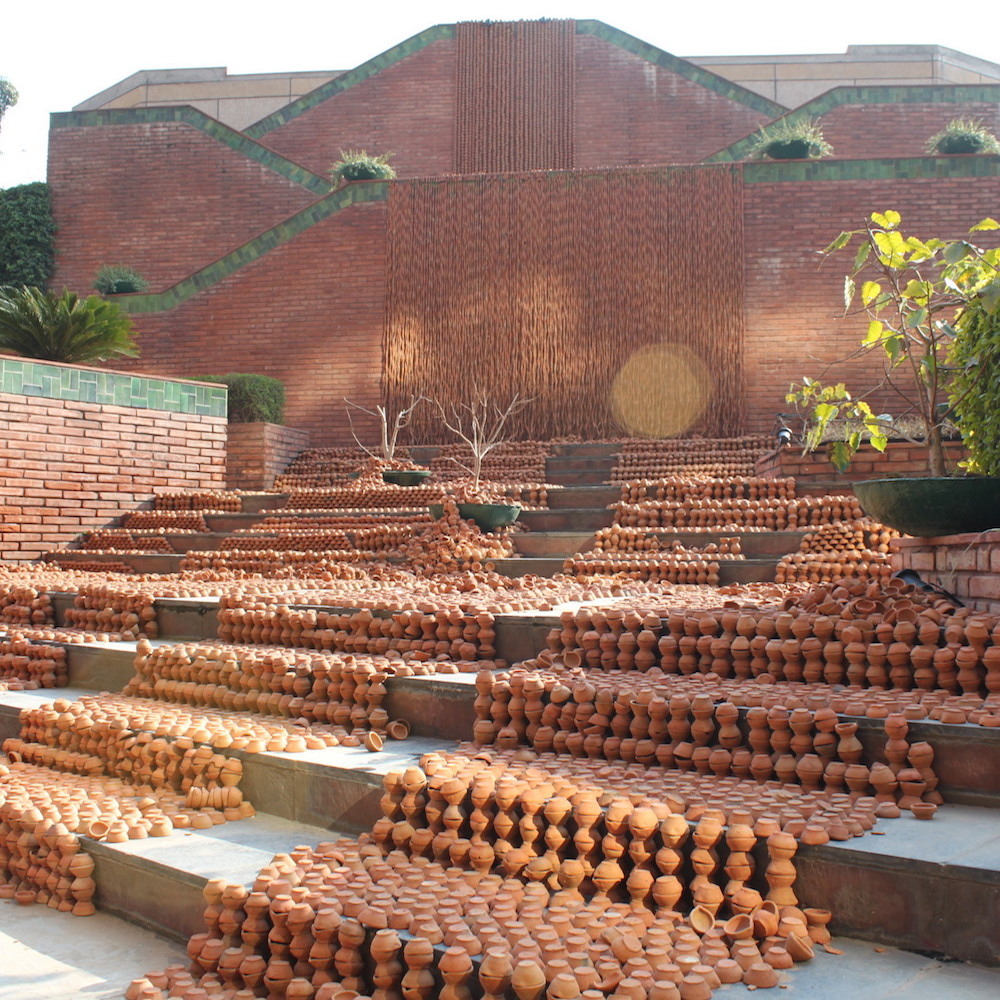Manav Gupta (b. 1967 in Kolkata, India) is an artist whose installations, performances and “mega-murals” often lead him into topics such as ecosystems, climate change and sustainable development. His biography states that global warming, man’s interference with nature and man’s disregard for environmental consciousness impact his work:
Just as his artist’s statement highlights “As I scrape the bottom of the soul for some ingredients the only way I can explain to myself, about what it all is, is to believe that in some past life (if there is one), I belonged to the rainforests. The mantra there, for survival, is to submit to the natural forces, bow before it, respect its ways, learn and grow.
One of his larger pieces of particular interest to ceramics lovers, is the pottery/architecture installation Excavations in Hymns of Clay. We’re reproducing portions of his artist statement on this particular work here, accompanied by photographs. From the artist:
Excavations in Hymns of Clay is a suite of environmental art installations by Manav Gupta where the artist deploys the quintessentially Indian potter’s produce of clay objects such as the earthen lamps (“diyas”), local cigar (“chilam”), earthen cups (“kullar”) and transforms their individual identity into metaphors and idioms of sustainability, context, perception and treatment as he conceptualizes and creates large scale avant-garde installations…
…Manav explores the essence of the vedic practices to subtly bring to light the repository of solutions that the ancient way of life could offer in today’s context of sustainable development and current issues around rivers like the Ganga…
Using the earthen lamp as a metaphor, Manav explores issues of environmental consciousness. We recognise and respect earth only when we use its resources for our use without reverence. Having been a part of the religious rituals many years and having grown up and lived this practice in India for years this whole symbolic circle of life has deeply affected the artist to use earthen lamps diyas as a metaphor to explore and raise questions on environmental consciousness and about the very glaring issue of how perception and context interplay each other. How men and objects are made to traverse responses and the destiny of reactions based on usage, perception, context and situation.
The earthen lamp is woven in the cultural-religious fabric of India from time immemorial. This humble small clay bowl called the diya is shaped by poor potters who keep them in large numbers by the road side in heaps for selling. Sometimes beside garbage dumps or beside sewage drains, they have a nondescript existence until the time they are bought home by people. Once home, only at the time of worship, they are used as a tool at the altar. Then something dramatic happens. The same humble small bowl of clay that had no meaning, no significance or existence in the human psyche suddenly turns into the medium of conveying the desires of the soul. Sacred as soon as it is placed at the altar. Priests say you do not need to purify these mud bowls by sprinkling it with the holy water of the Ganges because it is made of earth and is pure. Oil is poured in it. A wicker lit. And it assumes the status of the Holy Grail, carrying one‘s prayers of the soul to the Gods and our spirit awakens. Once the prayer ends, the earthen lamp is discarded again to be immersed in the Ganges. Taken for granted. Anointed when needed. Only revered when in use. And after its purpose is served, discarded and thrown and another one bought to serve the desires of the soul yet another day. Its life is strange as the way of the world and the circle of life. Like the unsung hymns of clay.
The artist has also taken his analogy from the Ganges. The sacred river of India has dedications that have always poured on it in many ways… Given today’s world of current complex issues of treatment and perception of women as well as earth (referred to as mother earth in many quarters of Indian spirituality), the artist draws a cross spectrum reference of eroding human values.
The pollution of the rivers, the shrinking of water and its availability and such other climate change issues have been in the artist’s ethos of work since beginning.
Sacred.
if you believe,
I lie
wrapped
in a heap
of nothingness.Unsung,
unlit,
unheard.
Till the end of time.At an altar
sometimes,
flames peep out
of my earthen palms.
An iridescent arch
woven by moonbeams.And your soul
sings your desires.manav
Text (edited) and images courtesy of Manav Gupta.
Do you love or loathe this work of contemporary ceramic art? Let us know in the comments.












Add your valued opinion to this post.